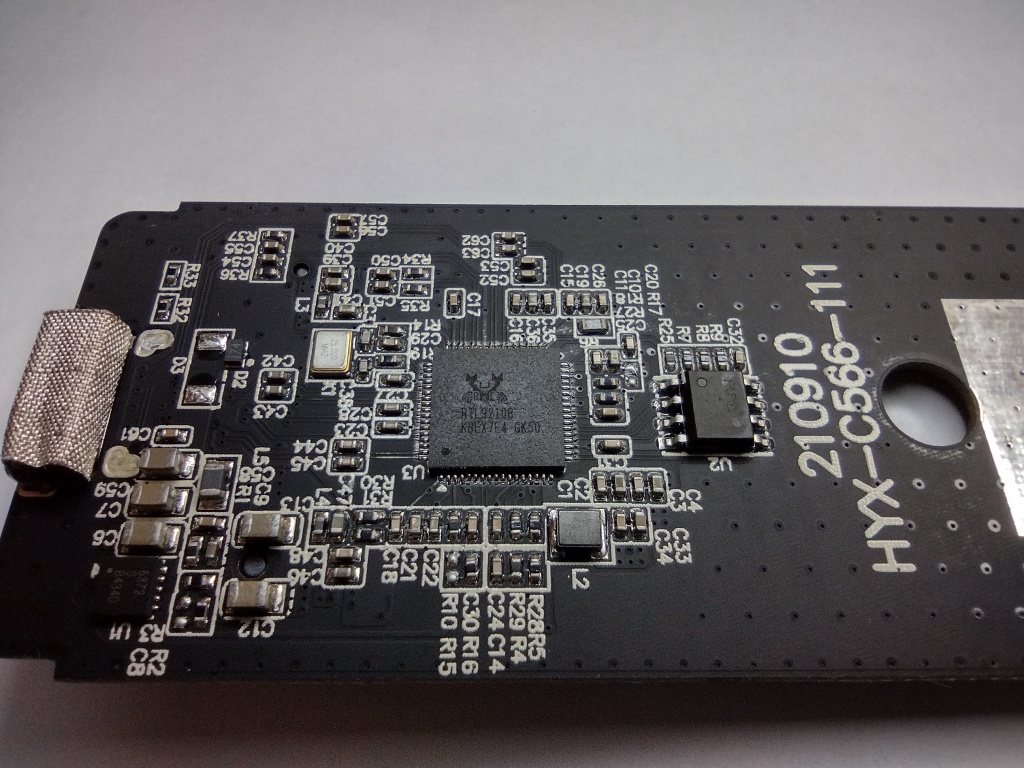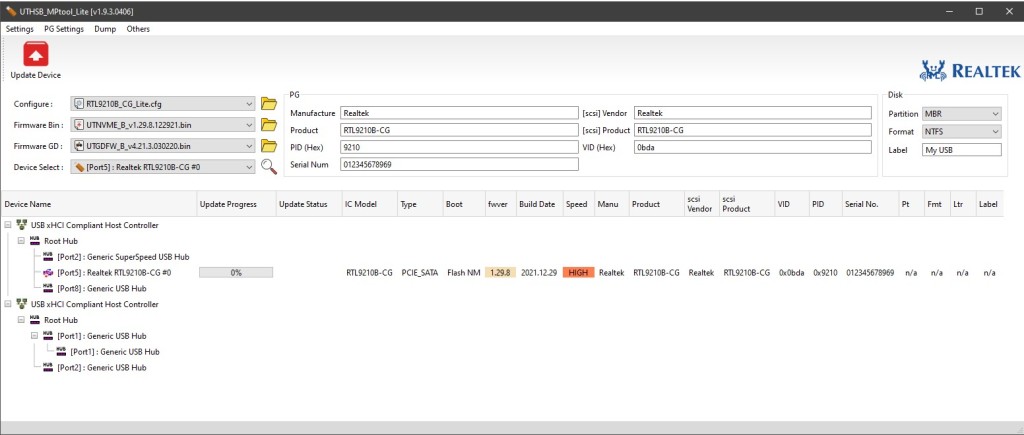[Updated 2023-06-01: addendum describing Uni’s updated model; added links to 2230-2280 SSD adapter]
- Introduction
- Feature summary
- Physical characteristics & unboxing
- Usability
- Performance
- Teardown
- Firmware
- Conclusion
- References
Introduction
Uni has a sleek design language consistent across products that features a clean brushed aluminum finish. Uni’s latest USB-C SSD enclosure departs somewhat from earlier products by complementing the brushed aluminum with black ABS plastic and a bright green rubberized grip. While still sophisticated on the whole, it looks a little more fun and less business-like.
Full disclosure: While this is not a sponsored post, the product(s) reviewed were provided at no cost for evaluation purposes. Products received in this capacity are destined for teardowns, future device interoperability testing, and/or charitable donations.
Feature summary
- USB-C 3.x Gen2 10Gb/s interface
- USB-C -> USB-C cable included (~50cm)
- M.2 SSD compatibility:
- sizes: 2242, 2260, 2280
- keys: M or M+B
- data: NVME or SATA
- Tool-less SSD installation
- Thermal pad included
Physical characteristics & unboxing
Like other Uni products, the packaging was a simple thin carboard box. Inside was the enclosure, a USB-C cable, and a user manual.
The enclosure is 37mm wide, 11mm thick, and 123.5mm long. The plastic grip portion makes up 25mm of the length with the rest being the extruded aluminum cover. The bright green finger grip opening measures 13.5mm x 26mm and is a hard rubbery plastic. The enclosure weighs ~47 grams and the cable ~22 grams. SSD modules can weigh anywhere between ~6-60 grams depending on the design, so overall weight is on the order of ~55-110 grams combined.




Usability
I had no problem installing both M.key and M+B-key 2280 sized SSDs. The large finger grip area makes sliding open the enclosure easy. The tool-less SSD installation concept is OK, but I’ve seen better. For folks with arthritis, it may be difficult to complete the install correctly the first time as the plastic retaining clip is quite small and easy to drop or misalign in its landing socket. Good thing they include a spare clip! Once the SSD is secured, you need to align the included grey thermal pad on top of the SSD chips correctly. If misaligned, there is a chance the aluminum cover can snag and drag the pad out of place. If this happens you have to open it back up and align the thermal pad again. I found that stretching the thermal pad taught over the SSD chips helped keep it in place and made sliding the aluminum cover easier. The cover closes confidently and snaps into place in the last few mm with plastic detents holding it firmly.
[Uni improved both the fastener and the thermal pad in an updated model – see addendum]
Uni’s paper instruction manual isn’t particularly helpful and some users might misinterpret the instructions and try to install the SSD on top of the thermal pad which just won’t fit! Also, the manual fails to mention that you may need to trim the thermal pad to install 2242 or 2260 size ssds. But the online guide and install video clears everything up. A Uni rep mentioned they are planning to change the packaging to place the thermal pad outside the enclosure to make it clearer you need to install it after the SSD.

Performance
For testing, I used an old Samsung PM951 256GB NVME SSD I pulled from a broken laptop PC. As expected, performance is lower on USB-C compared to a mainboard M.2 connector with PCIe Gen3x4. The theoretical maximum data rate for USB 3.x Gen2 is 1100MB/s with encoding, link management, and protocol overhead taken into account. In reality, it is rare to reach sustained read speeds over 1000MB/s on any USB Gen2 enclosure. So the performance shown in the benchmark below is OK and about the same as the competition. Thunderbolt 3 enclosures can exceed 2000MB/s when paired with a high-performance SSD but cost 3x as much and only work on Thunderbolt-enabled computers.


The software-reported SSD temperature was a few degrees lower in the Uni compared to my desktop. In my desktop, there was no heatsink on the SSD and its average temperature at idle was ~37°. In the Uni enclosure, it was ~34°. Under heavy use, temperatures rose by about 5-10°C in both cases. My SSD isn’t a particularly performant model, and I’m not sure if the lower transfer rates in the USB-C case affected temperatures – so it’s difficult to judge the performance of the Uni thermal pad and chassis. But the chassis does seem to work as a heatsink as it does get a little warm after 20 minutes or so. A better test would be to use a higher tier 2TB Samsung 980 Pro or WD Black SN850 and compare performance across a variety of SSD enclosures.
Teardown
There is not much to this or any other SSD enclosure. It’s a simple injection molded ABS plastic case, an extruded aluminum cover, a PCB, and thermal pads.
There are no PCB components adjacent to the M.2 connector where the SSD fits leaving a ~1.45mm gap between the SSD PCB and the Uni PCB. This means the enclosure can accommodate double-sided SSDs up to the D4 thickness standard. D5 thickness probably fits too, but it would be a bit tight and sliding the aluminum cover closed might be a challenge.
Unfortunately, the PCB layout prevents the inclusion of a spot to retain a 2230 SSD with the smallest size being 2242.






Firmware
Using the RealTek UTHSB_MPTool_Lite tool (also available from Plugable), I was able to dump the firmware info which showed build v1.23.9 from 2020. The latest available build is v1.29.8 (December 29 2021) which addresses stability with Samsung 980 Pro and WD SN550 SSDs and other minor improvements. I was able to use the tool to update my unit to the latest firmware in about 2 minutes.
**************************************************************
Device : [Port5] : Realtek RTL9210B-CG #0
**************************************************************
U2PHY : 02 f4 9b e0 e1
U3PHY : 02 d4 09 00 d5 00 80
VID : 0x0bda
PID : 0x9210
MANUFACTURE : "Realtek"
PRODUCT : "RTL9210B-CG"
SERIAL : "012345678930"
SCSI_PRODUCT : "RTL9210B-CG"
SCSI_VENDOR : "Realtek"
DISK_HOTPLUG : 0x00
LED : 0x02
PINMUX1 : 0x00000000
PINMUX2 : 0x00000070
U2_MAXPWR : 0xfa
U3_MAXPWR : 0x70
ASPMDIS : 0x00
PCIE_REFCLK : n/a
DISK_IPS_THRES : n/a
SWR_1_2V : n/a
EN_UPS : n/a
PD : n/a
CUSTOMIZED_LED : n/a
SUSPEND_LED_OFF : n/a
FORCE_USB_SPEED : n/a
FORCE_PCIE_SPEED : n/a
FORCE_USB_QUIRK : n/a
FORCE_PCIE_QUIRK : n/a
FAN : n/a
DIS_SHOW_EMPTY_DISK : 0x01
FORCE_SATA_NORMAL_DMA : n/a
UART_DBG_PIN : 0x05
FINGER_PRINT_EN : n/a
RM_INTERNAL_RD : n/a
HS_AUTO_SWITCH : n/a
FP_UART_BAUD_RATE : n/a
EFUSE :
00 01 02 03 04 05 06 07 08 09 0A 0B 0C 0D 0E 0F
-------------------------------------------------
0 ff ff ff ff ff ff ff ff ff ff ff ff ff ff ff ff
10 ff ff ff ff ff ff ff ff ff ff ff ff ff ff ff ff
20 ff ff ff ff ff ff ff ff ff ff ff ff ff ff ff ff
30 ff ff ff ff ff ff ff ff ff ff ff ff ff ff ff ff
40 ff ff ff ff ff ff ff ff ff ff ff ff ff ff ff ff
50 ff ff ff ff ff ff ff ff ff ff ff ff ff ff ff ff
60 ff ff ff ff ff ff ff ff ff ff ff ff ff ff ff ff
70 ff ff ff ff ff ff ff ff ff ff ff ff ff ff ff ff
80 ff ff ff ff ff ff ff ff ff ff ff ff ff ff ff ff
90 ff ff ff ff ff ff ff ff ff ff ff ff ff ff ff ff
a0 ff ff ff ff ff ff ff ff ff ff ff ff ff ff ff ff
b0 ff ff ff ff ff ff ff ff ff ff ff ff ff ff ff ff
Boot Mode : Flash NM
FW Ver : 1.23.9
FW Build Date : 2020.10.05
IC Ver : 0xa0010002
IC Pkg Type : PCIE_SATA
UUID : ffffffff-ffff-ffff-ffff-ffffffffffff
Disconn_ForceUSB2 : 0x00
Conclusion
Overall, I like the product. The fit and finish is good, as is the performance. The tool-less design isn’t the best I’ve tried, and my guess is that its primary goal was cost savings. The Plugable rubber grommet style is easier to use – but with the Uni’s large finger grip area, it is not that difficult. If Uni simply changed the plastic retaining clips to rubber like the Plugable, I think it would be perfect. Most customers will only install one or two SSDs during the life of the product so I can understand ease-of-use not being a top concern. But the green grip area is the saving grace here as it really adds confidence when handling the enclosure. While the grip does make the enclosure a little longer than other brands, it doesn’t impact the portability, so I think it is a decent design choice. Performance is on par with other products based on the RealTek RTL9210B chipset so no complaints there. The only missing feature is the ability to secure the smaller 2230 SSD size – but it is simple to purchase a 3rd-party 2230->2280 adapter or 3D-print your own. Unless you are planning to swap SSDs daily, I think the Uni enclosure is a solid choice and at the $30 price point ($25 with discount), I have no problem recommending it.
Addendum
Uni sent me an updated orange version of this enclosure which addresses most of my feedback. It includes these changes:
- soft rubber fastener that is much easier to lock the M.2 drive in place compared to the old hard plastic fastener
- longer PCB to better support full-size 2280 M.2 drives
- different style thermal pad that is easier to apply and doesn’t snag on enclosure
- clarified instruction manual
Good job Uni!


2 thoughts on “Uni USB-C M.2 enclosure review and teardown”